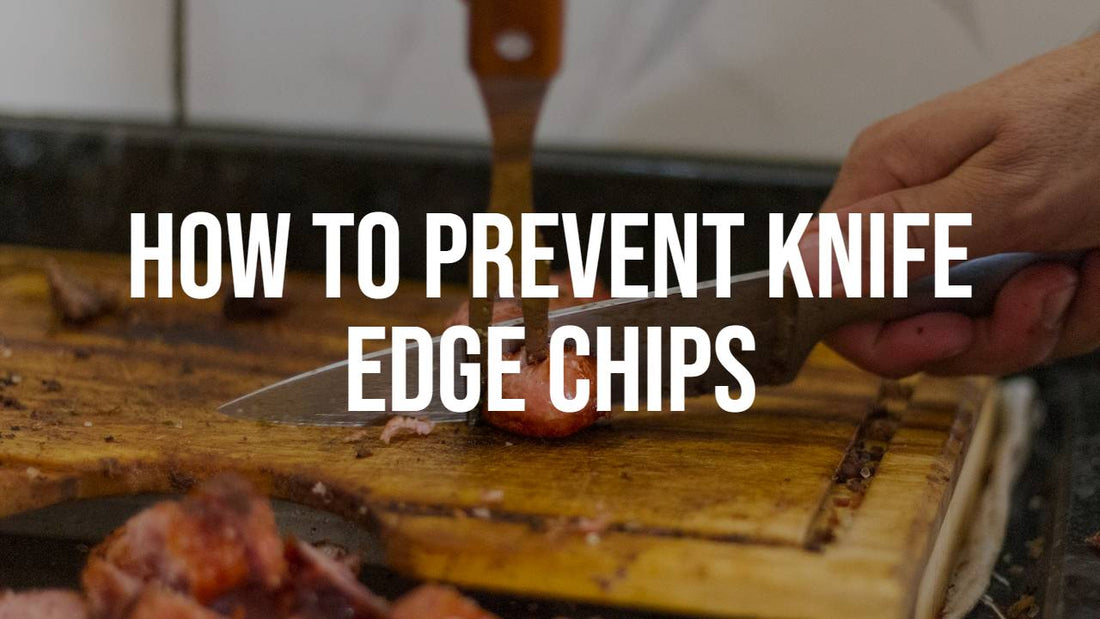
How to prevent knife edge chips?
Share
If you are a knife enthusiast, you probably know how frustrating it is to see your blade develop small nicks or cracks along the edge. These are called knife edge chips, and they can affect the performance and appearance of your knife.
Knife edge chips can make your blade dull, uneven, and prone to rust or corrosion. They can also increase the risk of injury when using your knife, as the chipped edge can snag or tear the material you are cutting.

What causes knife edge chips?
Knife edge chips can be caused by various factors, such as improper cutting technique, dull blade, hard or brittle materials, etc.
If you use your knife to chop or pry something that is too hard for the blade, you may damage the edge.
Sometimes, if you use a dull blade to cut something that requires a lot of force, you may create friction and heat that can weaken the edge.
There are also instances wherein you cut something that is too brittle or abrasive, such as glass or ceramic, you may chip off some of the metal from the edge.
Another factor is the edge angle. The thinness and sharpness of the blade depends on the angle. The smaller angle means a sharper edge. However, it compromises durability.
The quality of steel used also affects the performance of a knife. High quality steel has fewer impurities and defects which may weaken the knife when in use.
Lastly, the type of chopping board also plays a factor. There are cutting boards out there that are too hard or rough for your knife.
Glass, metal, stone or bamboo may damage the edge of the knife causing it to chip or dull faster.
How to prevent knife edge chips?
Fortunately, there are ways to prevent knife edge chips and to keep your blade in top condition. Here are some of them.
Tip 1: Use the right knife for the right task
Sounds common sense, right? However, home cooks, especially beginners, can get too preoccupied with what they are doing, get blindsided and forget the basics.
Different knives have different shapes, sizes, edge angles, and purpose. Using the right knife for the right task can make your work easier and more efficient.
For instance, slicing and chopping vegetables are for chef's knives since the large and curved blade will allow you to rock it back and forth. This will require minimum effort and reduces the chances of chipping the knife edge.
On the other hand, a paring knife is perfect for peeling and trimming fruits.
Point is, the right knife for the right task is not only more efficient and effective, but also safer. This will also prolong the life of your knife since you no longer have to exert too much effort or pressure in doing the job.

Tip 2: Sharpen your knife regularly
One of the best ways to prevent knife edge chips is to keep your knife in top-notch condition -- especially the blade.
Using a sharp knife will allow you to cut food with ease and precision while a dull knife requires more force.
You have to sharpen your knives if:
- You feel difficulty cutting your food.
- It slips or slides on the surface.
- If it tears or crushes your food instead of slicing it.
Take your time to sharpen your knife as it will also serve as your inspection session. Check if there are broken knife tips, cracks, edge chips, or imperfections that may cause an accident.
If you are too busy, then ordering a knife sharpening by mail service is also convenient since professionals will do the sharpening for you.
Mail in knife sharpening service providers such as FixKnife also offer Knife Edge Chip Repair.
Tip 3: Store your knife properly
Proper knife care includes storing them properly to protect its edge from damage and corrosion. This also reduces the risk of injury for anyone at home.
There are different ways to store your knife. You can use either a knife block, a magnetic knife strip, or a sheath and drawer divider.
Either of these options ensures that your knife are well protected from accidents.
Moreover, you should also avoid doing things that may damage your knife or anyone at home such as:
- Tossing your knife carelessly into the drawer
- Leaving them for too long in the sink
- Exposure to extreme moisture or heat
Final Thoughts
You need to prevent knife edge chips since like other utensils, knives are an investment. Failing to do these measures might end up in an accident and you do not want that to happen.
Besides efficiency and safety, preventing knife edge chips also saves you money since you do not need to repair or buy another knife set every now and then.
